Sweet potato puree is one of those simple, versatile recipes that fits perfectly into any kitchen. Whether you’re preparing a comforting side dish, a nutritious base for baby food, or an ingredient for baked goods, this smooth and naturally sweet potato puree delivers flavor and texture with very little effort.
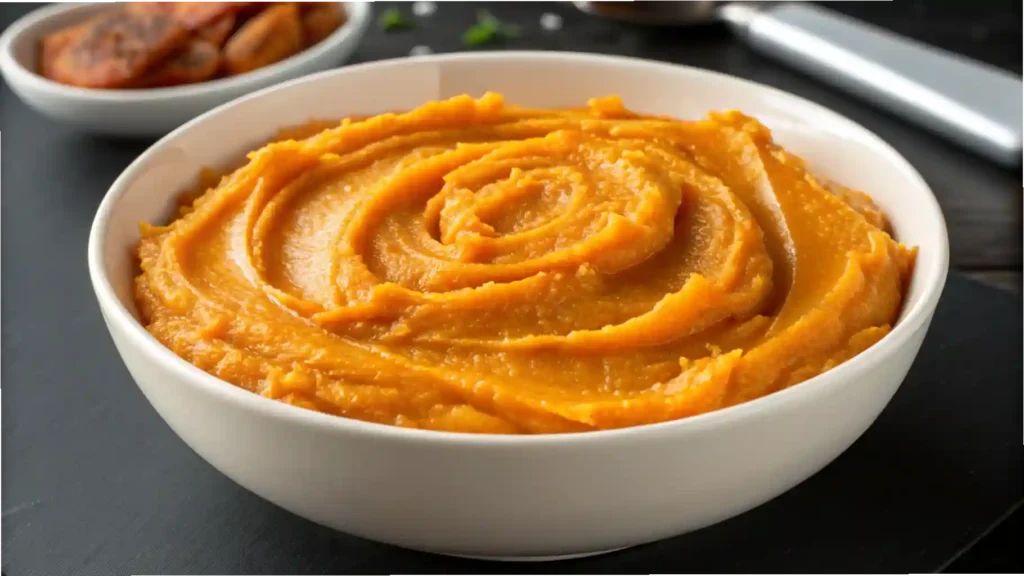
Made from cooked sweet potatoes that are blended until creamy, this dish is as nourishing as it is delicious. It’s easy to prepare ahead, simple to store, and useful in everything from soups and sauces to muffins and casseroles. The process is flexible—steam, roast, or boil—depending on your preference and tools.
In this guide, you’ll learn how to make sweet potato puree that’s smooth, rich, and ready for any purpose. Whether you’re feeding a baby or looking for a healthier substitute for mashed potatoes, this step-by-step method will help you achieve the perfect consistency every time.
Table of Contents
Why You’ll Love This Recipe
This sweet potato puree is more than just a basic blend—it’s a simple, nourishing, and flavorful foundation for countless dishes. These are the reasons this recipe is worth making again and again:
1. Naturally sweet and creamy
Sweet potatoes have a rich, earthy sweetness that shines through in every spoonful. When cooked until fork tender and pureed properly, the result is a soft, smooth texture that’s naturally satisfying—no extra sugar needed.
2. Perfect for all ages
From baby food to sophisticated sides, this puree works across age groups and meals. It’s gentle enough for stage 2 eaters yet elegant enough to serve with roasted meats or add to savory dishes.
3. Versatile and adaptable
Use it as a side dish, mix it into baked goods, or serve it with herbs and spices for a savory twist. It can even replace pumpkin puree or be added to smoothies for a nutritious boost.
4. Easy to prepare with multiple methods
You can boil, steam, or roast sweet potatoes depending on what’s most convenient. Each method brings a slightly different flavor and texture, but they all lead to a creamy, flavorful result.
5. Great for meal prep and storage
Once cooled, you can store the puree in an airtight container in the fridge or freeze it in ice cube trays for single-use portions—perfect for busy weeks or homemade sweet potato baby food.
6. Naturally nutritious
Packed with fiber, vitamins A and C, and antioxidants, this sweet potato recipe is a nutrient-dense option that fits into nearly any healthy eating plan.
Ingredients
This sweet potato puree recipe requires just a few basic ingredients, but the results are smooth, flavorful, and highly adaptable. Whether you’re preparing it for a side dish, baby food, or meal prep, these ingredients deliver natural sweetness and a silky texture.
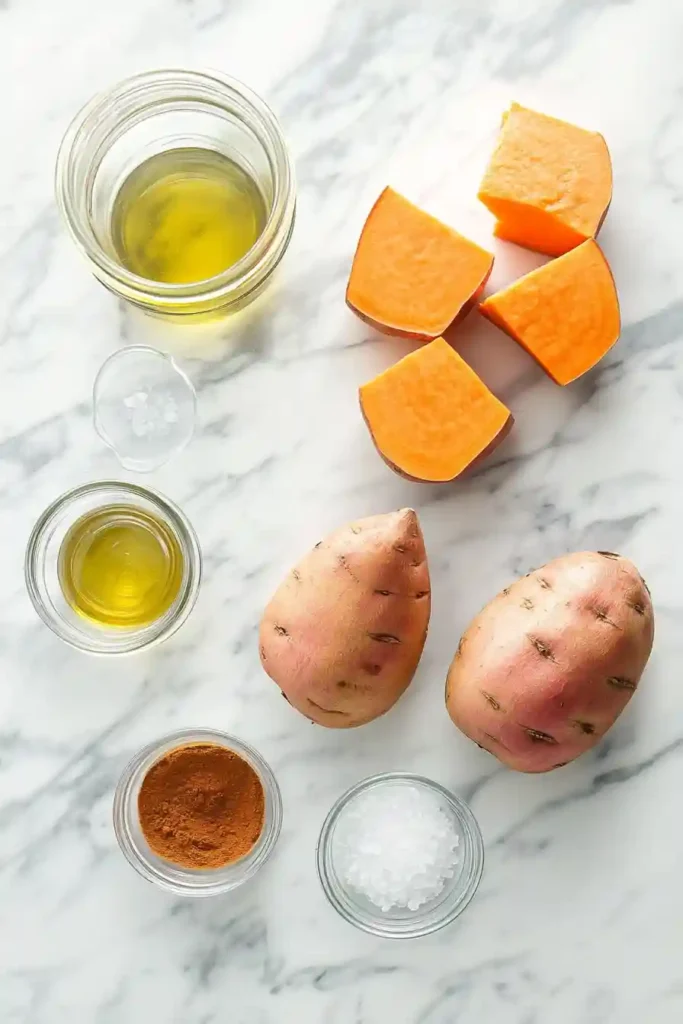
Main Ingredients
- 2 large sweet potatoes (or 3–4 medium)
Choose orange-fleshed sweet potatoes with smooth skin. These provide a creamy texture and rich flavor once cooked and pureed. - Water (for boiling or steaming)
Needed only if you’re boiling or steaming the potatoes. Use enough to fully cover the sweet potato chunks or to fill the bottom of a steamer basket.
Optional Add-Ins (for flavor variations)
- Pinch of salt and pepper (for savory use)
Enhances natural flavor when served as a side dish. - Cinnamon or nutmeg (for sweet variation)
Great for pairing with holiday meals or breakfast dishes. - Butter or olive oil (optional)
Adds richness and a smooth mouthfeel, especially if serving with dinner. - Breast milk, formula, or water (for baby food)
Helps loosen the puree to a smoother, baby-friendly consistency.
Tools You’ll Need
- Peeler – To remove skin before or after cooking.
- Sharp knife and cutting board – For slicing into even chunks.
- Large pot, steamer basket, or baking sheet – Depending on your cooking method.
- Colander (if boiling) – To drain excess water.
- Blender, food processor, or immersion blender – To achieve a smooth, lump-free puree.
- Airtight container – For storing leftovers in the fridge or freezer.
Instructions
This sweet potato puree is easy to make and can be prepared using several cooking methods—boiling, steaming, or roasting—depending on your preference. Each method leads to a smooth, flavorful puree that’s perfect for serving fresh or storing for later.
Step 1 – Wash and peel the sweet potatoes
- Rinse the sweet potatoes under cool water to remove dirt.
- Use a vegetable peeler to remove the skin, or leave the skin on if you plan to peel after cooking.
- Cut into evenly sized chunks to ensure they cook at the same rate.
Step 2 – Cook the sweet potatoes
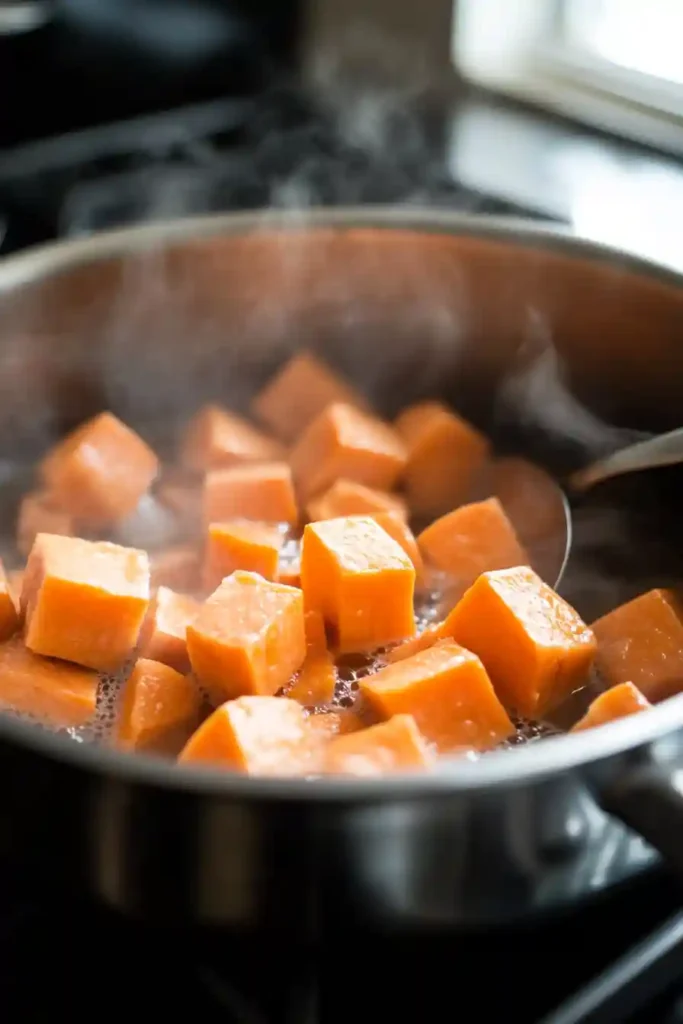
Choose one of the following methods:
Boiling
- Add the chopped sweet potatoes to a pot and pour in enough water to submerge them fully.
- Bring to a boil, then reduce heat and simmer for 12–15 minutes or until fork tender.
- Drain using a colander and let sit briefly to release excess moisture.
Steaming
- Add water to the bottom of a pot and place chunks in a steamer basket above the water.
- Cover and steam for 15–18 minutes or until easily pierced with a fork.
Roasting
- Preheat oven to 400°F (200°C).
- Use a fork to poke holes in the whole sweet potatoes, then arrange them on a baking tray.
- Roast for 45–50 minutes until soft. Let cool slightly, then peel.
Step 3 – Mash or blend the sweet potatoes
- Transfer cooked potatoes to a blender, food processor, or use an immersion blender.
- For a rustic mash, use a potato masher or the back of a fork.
- Blend until you reach a smooth consistency, adding a splash of water, milk, or broth as needed to adjust texture.
Step 4 – Adjust and serve or store
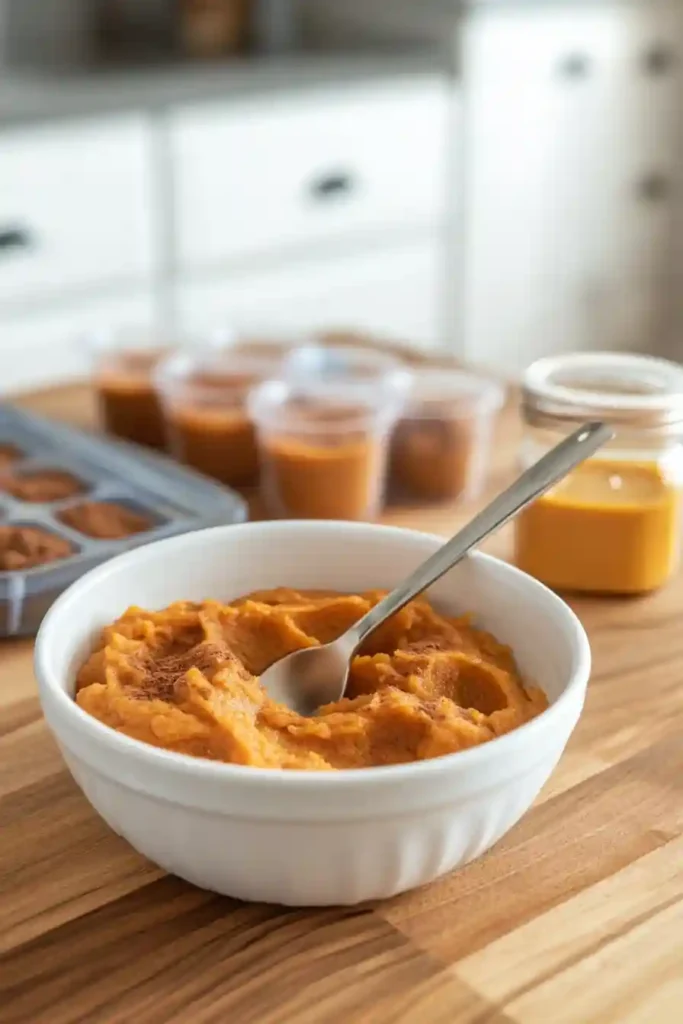
- For savory dishes, add salt and pepper or a drizzle of olive oil.
- For sweeter meals, mix in a dash of cinnamon, nutmeg, or even orange zest.
- Serve warm, or let the puree cool before storing.
Step 5 – Store properly
- Spoon the puree into an airtight container and refrigerate for up to 4 days.
- To freeze, transfer to ice cube trays or silicone molds. Once frozen, move to a freezer-safe bag.
- To reheat, thaw in the fridge overnight or warm gently on the stove or microwave.
Pro Tips and Variations
Creating the perfect sweet potato puree is all about choosing the right method and making small adjustments based on how you plan to use it. Whether you’re preparing it as baby food, a side dish, or a meal prep essential, these tips and variations will help you get the best flavor and texture every time.
Pro Tips for Success
1. Use evenly sized chunks
Cut the sweet potatoes into similar sizes so they cook at the same rate. This ensures all pieces are fork tender at the same time, preventing overcooked or undercooked spots.
2. Don’t overwater
When boiling, be sure to add only enough water to barely cover the surface of the potatoes. After cooking, let them sit in a colander for a minute or two to release excess moisture before blending. Too much water will thin the puree.
3. Blend for desired texture
For baby food, use a blender or food processor to get an ultra-smooth consistency. For a savory side, a slightly thicker texture using a potato masher works beautifully.
4. Store in portions
Freeze leftover puree in ice cube trays for quick, measured portions—perfect for baby meals, baking, or tossing into soups and sauces.
5. Taste before seasoning
Sweet potatoes have a naturally rich, sweet flavor. Taste the puree before adding salt, butter, or spices so you don’t overpower it.
Flavorful Variations
• Savory Garlic Puree
Blend in roasted garlic, olive oil, and a pinch of sea salt for a rich, savory side that pairs well with chicken or steak.
• Cinnamon-Spiced Sweet Puree
Add ground cinnamon, a touch of nutmeg, and a splash of maple syrup for a naturally sweet version ideal for breakfast or holiday meals.
• Herb-Infused Mash
Stir in chopped thyme, rosemary, or sage with a bit of butter for a fragrant side to serve with roasted vegetables or turkey.
• Creamy Baby Food Version
To make the puree soft enough for stage 2 feeding, mix in a small amount of warm water, breast milk, or formula until it’s easy to scoop.
• Vegan-Friendly Option
Use a touch of olive oil or dairy-free milk instead of butter for a completely plant-based version.
Serving Suggestions
This sweet potato puree is as flexible as it is flavorful. Whether you’re preparing a simple family meal, experimenting with seasonal pairings, or creating a smooth starter for your baby, here are some creative and practical ways to serve it.
Serve as a Cozy Side Dish
- Spoon the warm puree alongside roast chicken, or baked salmon for a naturally sweet, creamy contrast.
- Serve it instead of mashed potatoes during Thanksgiving or holiday meals with stuffing, cranberry sauce, and gravy.
- Add a drizzle of olive oil, a pat of butter, or a sprinkle of fresh herbs like thyme or sage for an elegant finish.
Perfect for Baby Food
- For babies in stage 2, serve this sweet potato puree plain or thinned slightly with breast milk, formula, or water.
- Freeze in small ice cube trays for easy portioning—just thaw as needed.
- Mix with pureed carrots, apples, or lentils for variety and added nutrition.
Add to Baked Goods and Breakfasts
- Stir the puree into muffins, pancake batter, or waffles for extra moisture and sweetness.
- Spread on toast with a pinch of cinnamon and honey for a quick, warming breakfast.
- Swirl into oatmeal or yogurt bowls for added fiber and flavor.
Incorporate into Other Recipes
- Use as a base for soups—combine with broth, garlic, and a splash of cream for a velvety fall soup.
- Mix into mac and cheese or casseroles for added creaminess and nutrition.
- Stir into pasta sauces or grain bowls for a subtle sweetness that balances savory elements.
Conclusion
Sweet potato puree is one of the simplest and most rewarding recipes you can add to your kitchen routine. With just a few ingredients and minimal effort, you get a smooth, flavorful base that works in everything from cozy dinners to baby meals and baked goods.
Its natural sweetness, creamy texture, and versatility make it ideal for a wide range of uses. Whether you’re serving it as a comforting side dish, mixing it into muffins, or offering it as baby food, this puree always delivers rich flavor and reliable results.
You can roast, steam, or boil your sweet potatoes depending on your schedule and taste preference. Blend until smooth, season if desired, and enjoy it warm or cold. Plus, it stores beautifully in the fridge or freezer, making it a smart addition to your meal prep lineup.
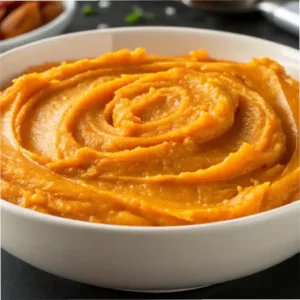
Sweet Potato Puree
Ingredients
Main Ingredients
- 2 large sweet potatoes or 3–4 medium
- Choose orange-fleshed sweet potatoes with smooth skin. These provide a creamy texture and rich flavor once cooked and pureed.
- Water for boiling or steaming
- Needed only if you’re boiling or steaming the potatoes. Use enough to fully cover the sweet potato chunks or to fill the bottom of a steamer basket.
Optional Add-Ins (for flavor variations)
- Pinch of salt and pepper for savory use
- Enhances natural flavor when served as a side dish.
- Cinnamon or nutmeg for sweet variation
- Great for pairing with holiday meals or breakfast dishes.
- Butter or olive oil optional
- Adds richness and a smooth mouthfeel especially if serving with dinner.
- Breast milk formula, or water (for baby food)
- Helps loosen the puree to a smoother baby-friendly consistency.
Tools You’ll Need
- Peeler – To remove skin before or after cooking.
- Sharp knife and cutting board – For slicing into even chunks.
- Large pot steamer basket, or baking sheet – Depending on your cooking method.
- Colander if boiling – To drain excess water.
- Blender food processor, or immersion blender – To achieve a smooth, lump-free puree.
- Airtight container – For storing leftovers in the fridge or freezer.
Instructions
Step 1 – Wash and peel the sweet potatoes
- Rinse the sweet potatoes under cool water to remove dirt.
- Use a vegetable peeler to remove the skin, or leave the skin on if you plan to peel after cooking.
- Cut into evenly sized chunks to ensure they cook at the same rate.
Step 2 – Cook the sweet potatoes
- Choose one of the following methods:
- Boiling
- Add the chopped sweet potatoes to a pot and pour in enough water to submerge them fully.
- Bring to a boil, then reduce heat and simmer for 12–15 minutes or until fork tender.
- Drain using a colander and let sit briefly to release excess moisture.
- Steaming
- Add water to the bottom of a pot and place chunks in a steamer basket above the water.
- Cover and steam for 15–18 minutes or until easily pierced with a fork.
- Roasting
- Preheat oven to 400°F (200°C).
- Use a fork to poke holes in the whole sweet potatoes, then arrange them on a baking tray.
- Roast for 45–50 minutes until soft. Let cool slightly, then peel.
Step 3 – Mash or blend the sweet potatoes
- Transfer cooked potatoes to a blender, food processor, or use an immersion blender.
- For a rustic mash, use a potato masher or the back of a fork.
- Blend until you reach a smooth consistency, adding a splash of water, milk, or broth as needed to adjust texture.
Step 4 – Adjust and serve or store
- For savory dishes, add salt and pepper or a drizzle of olive oil.
- For sweeter meals, mix in a dash of cinnamon, nutmeg, or even orange zest.
- Serve warm, or let the puree cool before storing.
Step 5 – Store properly
- Spoon the puree into an airtight container and refrigerate for up to 4 days.
- To freeze, transfer to ice cube trays or silicone molds. Once frozen, move to a freezer-safe bag.
- To reheat, thaw in the fridge overnight or warm gently on the stove or microwave.
Notes
- Calories: 120
- Total Fat: 0.3g
- Saturated Fat: 0g
- Cholesterol: 0mg
- Sodium: 60mg
- Total Carbohydrates: 28g
- Fiber: 4g
- Sugars: 6g
- Protein: 2g
- Vitamin A: 380% DV
- Vitamin C: 35% DV
- Potassium: 450mg
FAQs
Why not to boil sweet potatoes?
Boiling is convenient, but it can cause sweet potatoes to absorb excess water, which may dilute the flavor and make the puree thinner. For a richer taste and better texture, many prefer roasting or steaming, which preserve nutrients and natural sweetness.
How long to boil sweet potatoes for?
Boil peeled and cubed sweet potatoes for about 12 to 15 minutes until they are fork tender. If boiling whole, increase the time to 30 to 40 minutes depending on size. Test the softness by inserting a fork or knife—if it slides in easily, they’re ready.
Is sweet potato OK to eat everyday?
Sweet potatoes are loaded with nutrients and can be enjoyed on a regular basis as part of a balanced diet. They’re packed with fiber, vitamin A, and antioxidants. Just be mindful of portion sizes and avoid adding too much sugar or butter if you’re watching your diet.
How long to steam sweet potatoes?
Cut into chunks, sweet potatoes take about 15 to 18 minutes to steam until soft. They should be easily pierced with a fork. Steaming helps retain both flavor and nutrients, making it a great method for baby food or a clean, healthy side dish.
How do you thicken sweet potato puree?
If your puree turns out too thin, let it sit uncovered to release steam or return it to the stove and gently heat it to reduce moisture. You can also add a bit of mashed potato, instant oats, or pureed carrots to help it thicken naturally.
When should you not use sweet potatoes?
Avoid sweet potatoes that have soft spots, mold, or a sour smell. If they feel excessively mushy before cooking or have started to sprout and shrivel, they may no longer be safe or pleasant to eat.


